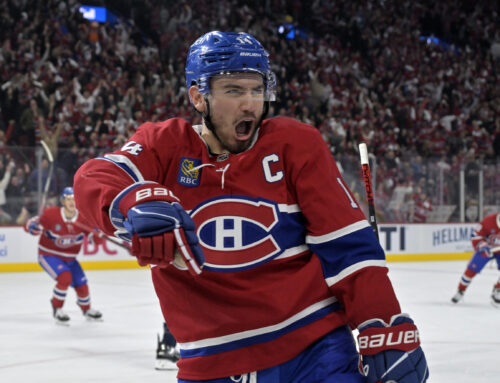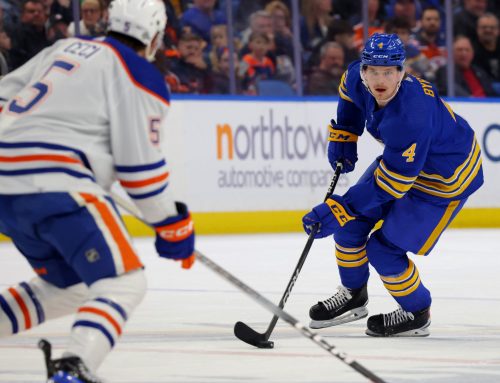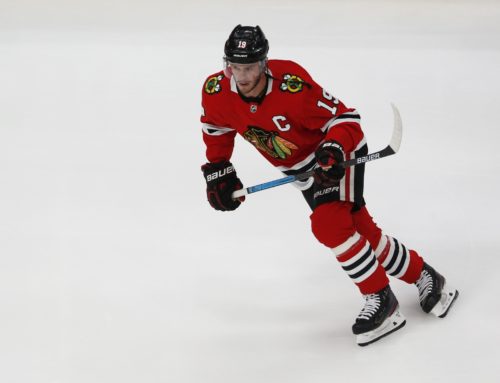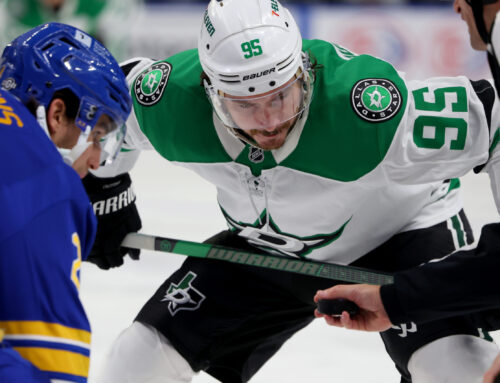
Some scoring trends from across the NHL, as well as some thoughts on Giroux and Thornton
****
When forecasting the future for fantasy hockey, or any fantasy sport, it’s important to keep an eye on trends, or emerging trends. Whether it be the home-run rate in baseball, the scarcity of the three-down running back in football, or the increased use of three-point attempts in basketball, fundamental changes to the way a game is played also changes fantasy values. I thought it would be a good exercise to see what is changing in the NHL, and whether it may be a blip or a trend. This is something I’ll return to over the summer as reviews and previews continue.
Most numbers are taken from Hockey Reference, with some from Corsica.
Goal Scoring
Despite all the complaints, goals per game actually went up in 2016-17 to a six-year high of 2.77 goals per team per game. There does appear to be a more concerted effort to create cleaner zone entries, or put another way, less dumping and chasing (though people who track the games would have a much better idea here than I would). One thing we do know is that it’s not because of power-play goals: there were 1428 PP goals in 2015-16, and that number fell to 1405 this past season.
Was it five-on-five? Well there were, per Corsica, 4471 five-on-five goals in the 2016-17 season compared to 4248 in 2015-16, 4404 in 2014-15, and 4398 in 2013-14 (which was the highest-scoring year on a per team basis over the last six seasons). Increased scoring at five-on-five, then, is a big reason for the increase in scoring overall.
There were also a handful more goals at three-on-three as well. The first year for 3v3 overtime was 2015-16, and we saw 139 goals. That went up to 156, but the uptick in goals in this department less than makes up for the drop in PP conversions.
The increase in scoring, then, seems largely caused by an increase in scoring at five-on-five. The next question would be to wonder why that is. My guess is that this is a two-fold answer: ever-increasing skill level at the bottom of rosters (fewer players that are strictly fighters/goons), and, as mentioned earlier, an increased focus on puck possession. I don’t mean ‘puck possession’ as short-hand for shot attempt differential, but actually possessing the puck rather than dumping and chasing. The people who track games like Corey Sznajder would have a better idea of what’s going on (and he’s worked on this extensively, as others have).
Power Plays
Yet again, power play opportunities are declining. After briefly increase from 2014-15 to 2015-16, they fell again last year to under three per game per team. The rate this past season of 2.99 is nearly half what it was in the first season after the 2005 lockout (5.85).
What is curious about power-play opportunities dropping is that the average power-play efficiency increased to a 24-year high of 19.1 percent; the last time league-wide power-play percentages averaged at least 19 percent was 1993-94. Even though it’s been a generation since power plays were this efficient, goal scoring on the man advantage is going down. All of the proposals to increase scoring like smaller goalie equipment, changing the size of nets, extending power plays the full two minutes regardless if a team scores, and on and on it goes, all of it is not necessary if referees called penalties as they should. Just going back to the level of power-play opportunities three years ago of 3.27 in 2013-14, at a 19.1 percent efficiency, would add about 130 goals. But I digress.
The question is whether or not the efficiency will improve. Judging by recent seasons, the NHL has no interest increasing the actual number of power plays, so the only way for teams to rack up more power-play goals is through increased efficiency. That’s a completely open-ended question, but it’ll be interesting to see the results after next season.
It’s important here for fantasy because fewer power-play goals means fewer power-play points to go around. If the number of opportunities keeps going down, but the efficiency stays relatively stable, power-play production drops (and I would guess the biggest hit, relatively speaking, comes from players on secondary units). This is just something to keep in mind going into drafts next year when factoring in secondary PP minutes.
****
It was a bad year offensively for Claude Giroux. He did manage 31 (!) power-play points, which is obviously great for fantasy owners using that category. He also finished with 58 points, his lowest in an 82-game season since 2010. His 14 goals were his lowest in an 82-game season since 2009.
What is most important here is the five (5) (!) primary assists Giroux had at five-on-five this past season. That’s one less than Derek Forbort, and the same number as Yannick Weber. This isn’t just a blip, either. Over his last six 82-game seasons, his 60-minute primary assist rate has dropped every year from a career-high 1.27 in 2010-11 to 0.26 in 2016-17. In fact, over the last three seasons, Giroux has the same aggregate primary assist rate (0.43) as Zemgus Girgensons, Patrick Eaves, and Tomas Hertl. That’s not good.
A few more stats, this time over the last three seasons, at five-on-five:
- Same number of points (79) as Colin Wilson.
- Same number of goals (30) as Lars Eller.
- Same number of assists (49) as Lee Stempniak.
- Same points per 60 minutes (1.39) as Nick Bjugstad.
- Same goals per 60 minutes (0.52) as Cal Clutterbuck.
- Same assists per 60 minutes (0.85) as Reilly Smith.
Keep in mind, this isn’t a small sample. This is over three seasons, and over 3000 minutes played. Giroux’s poor offensive performance at five-on-five isn’t a blip, it’s the norm.
The reason this is a problem, is, as noted above, power-play opportunities are dropping. It’s possible they go up next year, but that’s an uncertainty. Being able to rack up points at five-on-five is becoming increasingly important to raw production totals, and that is an area where Giroux is unsuccessful.
Not only is this worrisome due to declining power-play opportunities, it makes him fragile to a decrease in ice time. That’s part of the reason is totals dropped this year anyway.
To be fair here, it’s not all bad. It seems this is the type of year where everything went wrong for the Philadelphia captain all at the same time: he shot a career-low 7 percent; the Flyers scored on just 5.94 of shots with Giroux on the ice, another career-low; he managed a point on just 52.9 percent of the five-on-five goals that were scored with him on the ice which was, you guessed it, another career-low. We’ve seen these types of seasons before from players, and they can rebound, even if modestly – teammate Jakub Voracek did exactly that over the previous two seasons.
There are concerning trends however, with the primary assist plummeting for years, and his individual shot attempt rate declining for the second consecutive season. He should be better next year, but can he get back to the 70-plus point plateau we became accustomed to? It’s hard to say that at this point. At least he should be discounted at the draft table next year because of his performance last year.
****
Free agency is still a little over a month away, but fantasy owners are always running What If scenarios in their heads (I know I do). There is one player of particular intrigue, and it’s not Kevin Shattenkirk or TJ Oshie.
Even at this stage of his career, Thornton is an elite passer/setup man, which could help boost the scoring from wingers, and their power play. Which team needs help down the middle, on the power play, and has a closing Cup window? Montreal.
I am a Habs fan, so maybe this is wishful thinking. But they have over $23-million in cap space for next year, and the only big signing they need to make is Alex Radulov (Alex Galchenyuk, too, though it seems uncertain what his future is with this team). However, if the Habs could run Thornton/Galchenyuk/Danault/Plekanec as their four centres for a year, it would be a marked improvement over what they had last year.
This is the perfect time for the Canadiens to make such a move. There is a lot of cap space, they don’t have many significant signings to make, and even after next year, outside of Carey Price (and that’s a big one), there aren’t many unrestricted free agents the team needs to sign; the only UFAs the team has after the 2017-18 season are Plekaenc, Mitchell, and Emelin. In other words, thanks to generous team-friendly deals from guys like Max Pacioretty and Brendan Gallagher, the team can afford to make a short-term, high-dollar bet on a player that can help them significantly. Thornton is that guy.
There is a lot to consider here like what direction the team wants to make, how healthy Thornton will be coming off the knee injury, and what he’s looking for in free agency. Maybe he just re-signs with San Jose. Or maybe it’s just my Habs fandom showing again. Regardless, this seems to be a good fit on a team the skills he can bring.
2 Comments
Leave A Comment
You must be logged in to post a comment.





 BUF
BUF NYR
NYR CHI
CHI WSH
WSH CBJ
CBJ S.J
S.J VAN
VAN PIT
PIT ANA
ANA

I really enjoyed the insightful ramblings this morning. Just to complement your count data in the Goal Scoring section, here is the rate data:
5v5 GF60:
2016/17 = 2.25
2015/16 = 2.16
2014/15 = 2.23
2013/14 = 2.24
2012/13 = 2.25
PP GF60
2016/17 = 6.77
2015/16 = 6.66
2014/15 = 6.61
2013/14 = 6.47
2012/13 = 6.62
As you said, if refs called more penalties it would be a great boost to PP players going forward, as PP units seem to be getting more effective. With 5v5 scoring being so consistent, 5v5 production is very reliant on ice time.
What the GF60 numbers show is that if refs continue to call less powerplays, fantasy GM’s should increasingly focus on prioritizing players with good 5v5 scoring. However….if refs start calling more powerplays, players with good PP scoring rates should quickly be re-prioritized. An increase in PP icetime, coupled with the fact that PP efficiency is steadily increasing, creates the potential for massive point increases from players with high PP icetime.
I couldn’t believe how many games there were this season where the refs didn’t call a single penalty against a team. No team is that disciplined. If refs are calling the game properly, there should at the very least be 2 or 3 penalties called per team per game. Obviously refs are going to make some bad calls now and then (who wouldn’t?), but they have to actually make some!
Montreal definitely needs a good 2nd line C. Galchenyuk is terrible on faceoffs and needs to play on the wing. Thornton would likely be a good fit with the Habs, but I suspect he’ll stick with the Sharks.